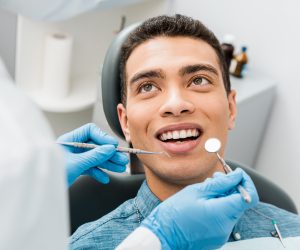Do you know what it means to relieve man of his pain and suffering? Anesthesia is the most humane of all of man’s accomplishments, and what a merciful accomplishment it was.
–Joseph Lewis
People tend to associate dental anesthesia with patients who have anxiety or phobia. Fear of the dentist is, in fact, widespread. In a worldwide survey, most of those asked said they have at least some level of dental fear. Many of the answers were specific: their biggest dental fear is pain.[1]
Special Needs Dentistry
Interested in more Special Needs
Dentistry posts from the Center for
Dental Anesthesia? Click here.
Fortunately, pain in dentistry is easy to control. Local anesthetics completely numb the area being worked on and is a viable solution for most patients. Lidocaine was introduced in back in 1948 and has since become the most common local anesthetic for dentistry in the world.[2]
For some patients, dental anxiety and phobia isn’t about pain: for them, the sights and smells of a dental office are intolerable. We have examined dental anxiety and phobia in detail elsewhere on this blog.[3]
People who stress out over dental appointments are not the only ones to benefit from anesthesia of one kind or another. Patients with health complications or special needs also rely on anesthesia to get the treatment they need, and for many of them local anesthesia is not enough. At The Center for Dental Anesthesia in Alexandria we are committed to caring for such patients. Anesthesia and sedation are among our specialties.[4]
Anesthesia and Sedation
Anesthesia, by definition, means a lack of sensation. Anesthesia might be mild, as with lidocaine, or much stronger.[5]
 Since local anesthetics numb the area being worked on, they are ideal for controlling pain in simple procedures like filling cavities. The patient is awake the entire time but won’t feel a thing.
Since local anesthetics numb the area being worked on, they are ideal for controlling pain in simple procedures like filling cavities. The patient is awake the entire time but won’t feel a thing.
Sedation is something more. The word “sedate” means to reduce nervousness or anxiety with medication, and sedation dentistry is used to relax nervous patients. The medications range from mild to strong.[6]
At The Center for Dental Anesthesia, determining the best sedative for any patient is done on a case-by-case basis. “The experience is personalized to have the minimal impact on the patient at all times,” says the CDA’s Dr. Zeyad Mady. “It all starts with a consultation and assessment of the patients’ wants and needs.”[7]
Special Needs And Health Complications
Anesthesia is a useful tool in special needs dentistry, and in medically complex cases. “Special needs” is an umbrella term that refers to people with emotional or behavioral issues, physical disabilities, or learning difficulties. Some people object to the term. “I was confused with all the ‘special needs’ this and that,” said the parent of a special needs child, who falls in that category herself. “‘Disability,’ I was and am completely used to.” The term is used here without any assumptions about those to whom it may refer.[8]
Many special needs patients are unable to remain calm or still during dental appointments. “Patients with dental phobias and/or special care needs typically still find these settings threatening,” says Dr. Mady. “Thus the CDA office was created to tackle such patients from all aspects; setting, sedation, experience and post-operative care.”
Medically complex cases refer to patients with underlying issues that complicate dental appointments. These include conditions like Alzheimer’s, Parkinson’s, and cancer.
Our goal is always patient comfort. No one should feel pain, discomfort, or stress when they go to the dentist. The CDA has a highly trained team that provides a safe and comfortable environment for dental care.
General Anesthesia
The strongest anesthesia in dentistry in general anesthesia. It puts the patient in a deep state of unconsciousness. Sometimes people call this being asleep. That’s okay as an informal term, but general anesthesia is the level used in surgical procedures and requires special equipment and trained providers.
General anesthesia is used for longer procedures. The patient will feel no pain, and afterward will have no memory of the procedure. It is an excellent option for patients with the highest levels of anxiety. It’s also a solution for certain special needs patients, in particular those with a history of behavior that interferes with treatment. With them, it may be needed for dental cleanings, as well as more involved procedures.
The Center For Dental Anesthesia in Alexandria provides a range of anesthesia options and is committed to high quality special needs dentistry. Dr. Zeyad Mady, Dr. James Geren, and the entire CDA team have advanced training in dental anesthesia and are committed to excellence in dentistry. Our doors are also open to the general public. Please call our office to schedule an appointment.
______
Notes
[1] “Study finds more than 60 percent of people suffer from dental fear,” Sept. 13 2018, Dental Products Report website. Referred to hereafter as Report.
https://www.dentalproductsreport.com/view/study-finds-more-60-percent-people-suffer-dental-fear
[2] “What You Need to Know About Dental Anesthesia”
https://www.healthline.com/health/dental-and-oral-health/dental-anesthesia
and “An emphasis on the wide usage and important role of local anesthesia in dentistry: A strategic review.”
[3] Report.
[4] “Benefits of Sedation Dentistry Services For Special Needs Patients.”
https://sedateme.com/2017/03/27/benefits-sedation-dentistry-services-special-needs-patients/
[5] “Guidelines for the Use of Sedation and General Anesthesia by Dentists,” American Dental Association.
https://www.ada.org/~/media/ADA/Education%20and%20Careers/Files/anesthesia_use_guidelines.pdf
[6] “What You Need to Know About Dental Anesthesia,” Healthline website.
https://www.healthline.com/health/dental-and-oral-health/dental-anesthesia
[7] Interview with Dr. Zeyad Mady, July 2019.
[8] Quote: “The Difference Between Special Needs and Disability”
https://www.meriahnichols.com/difference-special-needs-disability/
and “’Special needs’ is an ineffective euphemism”
https://www.ncbi.nlm.nih.gov/pmc/articles/PMC5256467/pdf/41235_2016_Article_25.pdf
